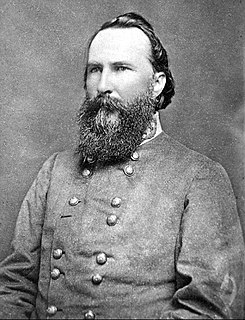
James Longstreet was one of the foremost Confederate generals of the American Civil War and the principal subordinate to General Robert E. Lee, who called him his "Old War Horse". He served under Lee as a corps commander for most of the battles fought by the Army of Northern Virginia in the Eastern Theater, and briefly with Braxton Bragg in the Army of Tennessee in the Western Theater.

Lucius Quintus Cincinnatus Lamar II was an American politician, diplomat, and jurist. A member of the Democratic Party, he represented Mississippi in both houses of Congress, served as the United States Secretary of the Interior, and was an Associate Justice of the Supreme Court of the United States. He also served as an official in the Confederate States of America.

John Bell Hood was a Confederate general during the American Civil War. Although brave, Hood's impetuosity led to high losses among his troops as he moved up in rank. Bruce Catton wrote that "the decision to replace Johnston with Hood was probably the single largest mistake that either government made during the war." Hood's education at the United States Military Academy led to a career as a junior officer in the infantry and cavalry of the antebellum U.S. Army in California and Texas. At the start of the Civil War, he offered his services to his adopted state of Texas. He achieved his reputation for aggressive leadership as a brigade commander in the army of Robert E. Lee during the Seven Days Battles in 1862, after which he was promoted to division command. He led a division under James Longstreet in the campaigns of 1862–63. At the Battle of Gettysburg, he was severely wounded, rendering his left arm useless for the rest of his life. Transferred with many of Longstreet's troops to the Western Theater, Hood led a massive assault into a gap in the Union line at the Battle of Chickamauga, but was wounded again, requiring the amputation of his right leg.

The Army of Tennessee was the principal Confederate army operating between the Appalachian Mountains and the Mississippi River during the American Civil War. It was formed in late 1862 and fought until the end of the war in 1865, participating in most of the significant battles in the Western Theater.
Longstreet or Long Street may refer to:

The Battle of Fort Sanders was the crucial engagement of the Knoxville Campaign of the American Civil War, fought in Knoxville, Tennessee, on November 29, 1863. Assaults by Confederate Lt. Gen. James Longstreet failed to break through the defensive lines of Union Maj. Gen. Ambrose Burnside, resulting in lopsided casualties, and the Siege of Knoxville entered its final days.
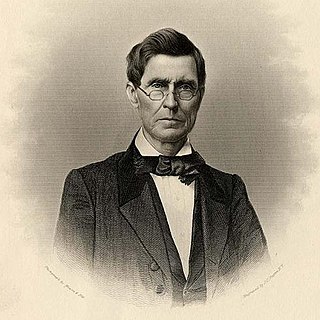
Augustus Baldwin Longstreet was an American lawyer, minister, educator, and humorist, known for his book Georgia Scenes. He was the uncle of the senior Confederate General James Longstreet. He held pro-slavery and pro-secessionist views, personally owning dozens of slaves throughout his life. He held the presidency positions at several southern universities including, the University of Mississippi (twice), South Carolina College, and Emory College.

The Battle of Appomattox Court House, fought in Appomattox County, Virginia, on the morning of April 9, 1865, was one of the last battles of the American Civil War (1861–1865). It was the final engagement of Confederate General in Chief, Robert E. Lee, and his Army of Northern Virginia before they surrendered to the Union Army of the Potomac under the Commanding General of the United States Army, Ulysses S. Grant.

Benjamin Huger was a regular officer in the United States Army, who served with distinction as chief of ordnance in the Mexican–American War and in the American Civil War, as a Confederate general. He notably surrendered Roanoke Island and then the rest of the Norfolk, Virginia shipyards, attracting criticism for allowing valuable equipment to be captured. At Seven Pines, he was blamed by General James Longstreet for impeding the Confederate attack, and was transferred to an administrative post after a lacklustre performance in the Seven Days Battles.

Lafayette McLaws was a United States Army officer and a Confederate general in the American Civil War. He served at Antietam and Fredericksburg, where Robert E. Lee praised his defense of Marye's Heights, and at Gettysburg, where his division made successful assaults through the Peach Orchard and Wheatfield, but was unable to dislodge Union forces from Cemetery Ridge. After the Knoxville Campaign, he was court-martialed for inefficiency, though this was overturned for procedural reasons. Finally he was sent to his native Georgia to resist Sherman's March to the Sea, but had to retreat through the Carolinas, losing many men through desertion, and is presumed to have surrendered with Joseph E. Johnston in April 1865.

The siege of Knoxville saw Lieutenant General James Longstreet's Confederate forces besiege the Union garrison of Knoxville, Tennessee, led by Major General Ambrose Burnside. When Major General William T. Sherman approached Knoxville with an overwhelming Union force, Longstreet ended the siege on December 4 and withdrew northeast. The siege was part of the Knoxville campaign of the American Civil War.
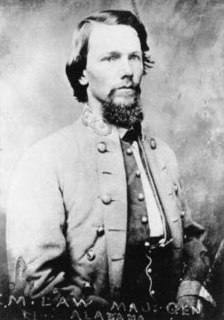
Evander McIver Law was an author, teacher, and a Confederate general in the American Civil War.
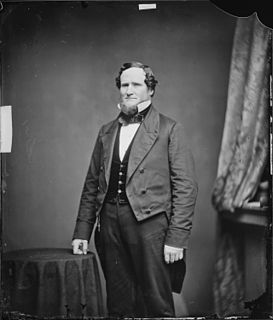
William Barksdale was a lawyer, newspaper editor, US Representative, and Confederate general in the American Civil War. A staunch secessionist, he was mortally wounded during the Battle of Gettysburg while he led his brigade's attack on Union forces not far from Cemetery Ridge.

General Sir Arthur James Lyon Fremantle was a British Army officer and a notable British witness to the Battle of Gettysburg during the American Civil War. Whilst holding the rank of "Captain and Lieutenant Colonel" he spent three months in North America, travelling through parts of the Confederate States of America and the Union. Contrary to popular belief, Colonel Fremantle was not an official representative of the United Kingdom; instead, he was something of a war tourist.

The Knoxville campaign was a series of American Civil War battles and maneuvers in East Tennessee during the fall of 1863 designed to secure control of the city of Knoxville and with it the railroad that linked the Confederacy east and west, and position the First Corps under Longstreet for return to the Army of Northern Virginia. Union Army forces under Maj. Gen. Ambrose Burnside occupied Knoxville, Tennessee, and Confederate States Army forces under Lt. Gen. James Longstreet were detached from Gen. Braxton Bragg's Army of Tennessee at Chattanooga to prevent Burnside's reinforcement of the besieged Federal forces there. Ultimately, Longstreet's Siege of Knoxville ended when Union Maj. Gen. William Tecumseh Sherman led elements of the Army of the Tennessee and other troops to Burnside's relief after Union troops had broken the Confederate siege of Chattanooga. Although Longstreet was one of Gen. Robert E. Lee's best corps commanders in the East in the Army of Northern Virginia, he was unsuccessful in his attempt to penetrate the Knoxville defenses and take the city.

Henry Thomas Harrison, often known simply as "Harrison", was a spy for Confederate Lieutenant General James Longstreet during the American Civil War. He is best known for the information he gave Longstreet and General Robert E. Lee in the Gettysburg Campaign, which resulted in Lee converging on Gettysburg, Pennsylvania, thus causing the Battle of Gettysburg in July 1863.
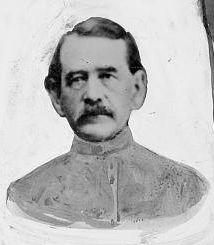
William Thompson Martin was an American lawyer and politician who became a Confederate States Army major general during the American Civil War. He later served in the Mississippi state senate, and was a delegate to four Democratic National Conventions. Martin was the president of the Natchez, Jackson, and Columbus Railroad, of which he oversaw the construction in 1884.

The Chattanooga campaign was a series of maneuvers and battles in October and November 1863, during the American Civil War. Following the defeat of Maj. Gen. William S. Rosecrans's Union Army of the Cumberland at the Battle of Chickamauga in September, the Confederate Army of Tennessee under Gen. Braxton Bragg besieged Rosecrans and his men by occupying key high terrain around Chattanooga, Tennessee. Maj. Gen. Ulysses S. Grant was given command of Union forces in the West, now consolidated under the Division of the Mississippi. Significant reinforcements also began to arrive with him in Chattanooga from Mississippi and the Eastern Theater. On October 18, Grant removed Rosecrans from command of the Army of the Cumberland and replaced him with Major General George Henry Thomas.

The Battle of Brown's Ferry was an engagement of the American Civil War which took place on October 27, 1863 in Hamilton County, Tennessee. During the battle, two Union brigades drove Confederate sharpshooters from the Tennessee River, which allowed supplies to start arriving to the Union army at Chattanooga. Although a minor engagement, the battle proved to have significant results in paving the way for the Union victory at Chattanooga a month later.




















